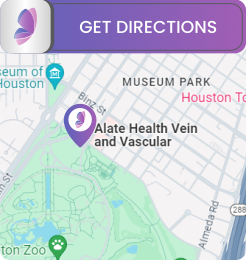Prostate Artery Embolization (PAE) Treatment Specialist in Houston TX
Do you suffer from moderate to severe enlarged prostate symptoms and are looking for a less invasive alternative to traditional surgery? Prostatic Artery Embolization is the right choice for you. At Alate Health Interventional Radiology Clinic Andrew Doe, MD, offers prostate artery embolization treatment. The success of PAE in alleviating symptoms such as urinary frequency, urgency, and weak stream can be long-lasting, with many individuals enjoying the associated benefits for years after the treatment. For more information, please contact us today or book an appointment online. We are conveniently located at 1213 Hermann Dr Suite 255, Houston, TX 77004.




Table of Contents:
What is prostatic artery embolization (PAE)?
How can I determine if prostatic artery embolization is appropriate for me?
How successful is PAE for the prostate?
How long does the PAE procedure last?
Prostatic Artery Embolization (PAE) is a minimally invasive medical procedure that is typically used to treat symptoms of benign prostatic hyperplasia (BPH). BPH is commonly known as an enlarged prostate.
This procedure involves the insertion of a catheter through a small incision in the groin or arm. A provider at Alate Health Interventional Radiology Clinic guides the catheter into the prostatic arteries using imaging technology.
Once positioned, microscopic particles are injected to block the blood flow to the prostate, leading to a reduction in prostate size and alleviation of symptoms.
PAE is designed to offer relief from the urinary symptoms associated with BPH, such as frequent urination, urgency, and many others, without the need for more invasive surgical procedures. By reducing the blood supply to the prostate, the gland shrinks, which can significantly improve urinary function for many patients.
This procedure is generally performed under moderate sedation, and patients can often return home the same day making it convenient and effective.
Determining if Prostatic Artery Embolization (PAE) is suitable involves a consultation with a specialist at Alate Health Interventional Radiology Clinic who can assess your symptoms and medical history.
Ideal candidates are typically those who suffer from moderate to severe BPH symptoms and are looking for a less invasive alternative to traditional surgery.
Before recommending PAE, a healthcare provider will conduct a thorough assessment, including imaging tests like MRI or CT scans, to visualize the prostate as well as the surrounding blood vessels. Patients who opt for PAE often seek to avoid the potential complications and side effects of surgical procedures, such as sexual dysfunction or incontinence.
This procedure may also provide an excellent option for those who have not responded well to medications or who are concerned about potential side effects. Discussing your symptoms, lifestyle, and treatment goals with your doctor can help determine whether PAE is the most appropriate treatment option.
How successful PAE will be for the prostate varies on an individual basis but for many patients it is a highly effective solution. PAE has been associated with high success rates in reducing the symptoms of benign prostatic hyperplasia (BPH).
Clinical studies report that many patients experience significant improvement in urinary symptoms and quality of life following the procedure. The success of PAE in alleviating symptoms such as urinary frequency, urgency, and weak stream can be long-lasting, with many individuals enjoying the associated benefits for years after the treatment.
The effectiveness of PAE depends on various factors, including the size of the prostate and the specific anatomy of the patient’s prostatic arteries. It is important for patients to approach treatment with realistic expectations and understand that while PAE is highly effective for many, it is not a guaranteed solution for all.
Regular follow-up visits with the healthcare provider are helpful to monitor the outcomes and address any concerns post-procedure.
The Prostatic Artery Embolization (PAE) procedure typically lasts between one to three hours, depending on the complexity of the case, the specific anatomy of the prostate arteries, and other individual health factors.
The procedure is performed under sedation, and patients usually remain awake but relaxed throughout. After the procedure, patients generally spend a few hours in recovery before being discharged to go home the same day.
Following PAE, most patients are able to resume normal activities within a few days, with complete recovery varying from person to person. It’s important for patients to follow post-procedure instructions, which may include taking prescribed medications and attending follow-up appointments to ensure the best possible outcome.
The immediate effects on urinary symptoms can begin to improve within a few days, with continued and more significant progress occurring over the following months as the prostate gradually decreases in size.
Patients can expect long term benefits with necessary follow-up appointments and aftercare as needed.
Prostatic Artery Embolization (PAE) is available at Alate Health Interventional Radiology Clinic. For more information, contact us today or book an appointment online. We are conveniently located at 1213 Hermann Dr Suite 255, Houston, TX 77004. We serve patients from Houston TX, Bellaire TX, Jacinto City TX, Spring Valley Village TX, Stafford TX, Bunker Hill Village TX, and surrounding cities.
PROSTATE ARTERY EMBOLIZATION PAE
Check Out Our 5 Star Reviews


Additional Services You May Need
▸ Adenomyosis
▸ Enlarged Prostate
▸ Leg Ulcers
▸ Joint Pain
▸ Varicose Veins
▸ Uterine Fibroids
▸ Pelvic Congestion
▸ Vascular Malformations
▸ Dialysis/Renal Failure
▸ Port and PICC Placements
▸ Peripheral Arterial Disease
▸ Primary and Metastatic Liver Cancers
▸ Hemorrhoid Artery Embolization (HAE)







